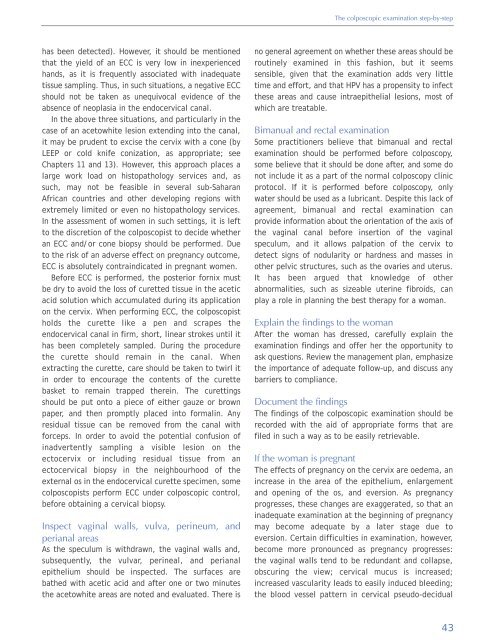Colposcopy and Treatment of Cervical Intraepithelial Neoplasia - RHO
Colposcopy and Treatment of Cervical Intraepithelial Neoplasia - RHO
Colposcopy and Treatment of Cervical Intraepithelial Neoplasia - RHO
You also want an ePaper? Increase the reach of your titles
YUMPU automatically turns print PDFs into web optimized ePapers that Google loves.
The colposcopic examination step-by-step<br />
has been detected). However, it should be mentioned<br />
that the yield <strong>of</strong> an ECC is very low in inexperienced<br />
h<strong>and</strong>s, as it is frequently associated with inadequate<br />
tissue sampling. Thus, in such situations, a negative ECC<br />
should not be taken as unequivocal evidence <strong>of</strong> the<br />
absence <strong>of</strong> neoplasia in the endocervical canal.<br />
In the above three situations, <strong>and</strong> particularly in the<br />
case <strong>of</strong> an acetowhite lesion extending into the canal,<br />
it may be prudent to excise the cervix with a cone (by<br />
LEEP or cold knife conization, as appropriate; see<br />
Chapters 11 <strong>and</strong> 13). However, this approach places a<br />
large work load on histopathology services <strong>and</strong>, as<br />
such, may not be feasible in several sub-Saharan<br />
African countries <strong>and</strong> other developing regions with<br />
extremely limited or even no histopathology services.<br />
In the assessment <strong>of</strong> women in such settings, it is left<br />
to the discretion <strong>of</strong> the colposcopist to decide whether<br />
an ECC <strong>and</strong>/or cone biopsy should be performed. Due<br />
to the risk <strong>of</strong> an adverse effect on pregnancy outcome,<br />
ECC is absolutely contraindicated in pregnant women.<br />
Before ECC is performed, the posterior fornix must<br />
be dry to avoid the loss <strong>of</strong> curetted tissue in the acetic<br />
acid solution which accumulated during its application<br />
on the cervix. When performing ECC, the colposcopist<br />
holds the curette like a pen <strong>and</strong> scrapes the<br />
endocervical canal in firm, short, linear strokes until it<br />
has been completely sampled. During the procedure<br />
the curette should remain in the canal. When<br />
extracting the curette, care should be taken to twirl it<br />
in order to encourage the contents <strong>of</strong> the curette<br />
basket to remain trapped therein. The curettings<br />
should be put onto a piece <strong>of</strong> either gauze or brown<br />
paper, <strong>and</strong> then promptly placed into formalin. Any<br />
residual tissue can be removed from the canal with<br />
forceps. In order to avoid the potential confusion <strong>of</strong><br />
inadvertently sampling a visible lesion on the<br />
ectocervix or including residual tissue from an<br />
ectocervical biopsy in the neighbourhood <strong>of</strong> the<br />
external os in the endocervical curette specimen, some<br />
colposcopists perform ECC under colposcopic control,<br />
before obtaining a cervical biopsy.<br />
Inspect vaginal walls, vulva, perineum, <strong>and</strong><br />
perianal areas<br />
As the speculum is withdrawn, the vaginal walls <strong>and</strong>,<br />
subsequently, the vulvar, perineal, <strong>and</strong> perianal<br />
epithelium should be inspected. The surfaces are<br />
bathed with acetic acid <strong>and</strong> after one or two minutes<br />
the acetowhite areas are noted <strong>and</strong> evaluated. There is<br />
no general agreement on whether these areas should be<br />
routinely examined in this fashion, but it seems<br />
sensible, given that the examination adds very little<br />
time <strong>and</strong> effort, <strong>and</strong> that HPV has a propensity to infect<br />
these areas <strong>and</strong> cause intraepithelial lesions, most <strong>of</strong><br />
which are treatable.<br />
Bimanual <strong>and</strong> rectal examination<br />
Some practitioners believe that bimanual <strong>and</strong> rectal<br />
examination should be performed before colposcopy,<br />
some believe that it should be done after, <strong>and</strong> some do<br />
not include it as a part <strong>of</strong> the normal colposcopy clinic<br />
protocol. If it is performed before colposcopy, only<br />
water should be used as a lubricant. Despite this lack <strong>of</strong><br />
agreement, bimanual <strong>and</strong> rectal examination can<br />
provide information about the orientation <strong>of</strong> the axis <strong>of</strong><br />
the vaginal canal before insertion <strong>of</strong> the vaginal<br />
speculum, <strong>and</strong> it allows palpation <strong>of</strong> the cervix to<br />
detect signs <strong>of</strong> nodularity or hardness <strong>and</strong> masses in<br />
other pelvic structures, such as the ovaries <strong>and</strong> uterus.<br />
It has been argued that knowledge <strong>of</strong> other<br />
abnormalities, such as sizeable uterine fibroids, can<br />
play a role in planning the best therapy for a woman.<br />
Explain the findings to the woman<br />
After the woman has dressed, carefully explain the<br />
examination findings <strong>and</strong> <strong>of</strong>fer her the opportunity to<br />
ask questions. Review the management plan, emphasize<br />
the importance <strong>of</strong> adequate follow-up, <strong>and</strong> discuss any<br />
barriers to compliance.<br />
Document the findings<br />
The findings <strong>of</strong> the colposcopic examination should be<br />
recorded with the aid <strong>of</strong> appropriate forms that are<br />
filed in such a way as to be easily retrievable.<br />
If the woman is pregnant<br />
The effects <strong>of</strong> pregnancy on the cervix are oedema, an<br />
increase in the area <strong>of</strong> the epithelium, enlargement<br />
<strong>and</strong> opening <strong>of</strong> the os, <strong>and</strong> eversion. As pregnancy<br />
progresses, these changes are exaggerated, so that an<br />
inadequate examination at the beginning <strong>of</strong> pregnancy<br />
may become adequate by a later stage due to<br />
eversion. Certain difficulties in examination, however,<br />
become more pronounced as pregnancy progresses:<br />
the vaginal walls tend to be redundant <strong>and</strong> collapse,<br />
obscuring the view; cervical mucus is increased;<br />
increased vascularity leads to easily induced bleeding;<br />
the blood vessel pattern in cervical pseudo-decidual<br />
43
















